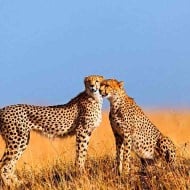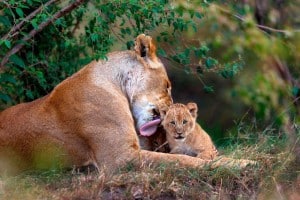
Travel to Kenya for a superb safari and beach holidays
Kenya has for many years been one of the most popular destinations for safari in Africa, and one understands well why first Karen Blixen and since many animal lovers have fallen in love with the country.
You are impressed every time you travel to Kenya. Here are world-famous national parks with a diverse nature of large, open plains in the Masai Mara, lush life around Lake Naivasha, incredible views of Mount Kenya and white sandy beaches on the Mombasa coast. And then it is on trips to Kenya, you can meet all of Africa’s famous, wild animals on a classic Kenya safari. You must experience all this in Kenya as part of your safari in Africa.
Masai Mara National Park – world-class safari holiday
Masai Mara is the most famous national park for safari in Kenya and a must visit on all trips to Kenya. The national park in southwestern Kenya encounters its 1,500 square kilometers up to the Serengeti in Tanzania, and millions of animals roam the open plains year-round. If there was a prize for the world’s best wildlife, Masai Mara would be nominated if not winning it
On safari in the Masai Mara you will see the large cats such as lions, leopards and cheetahs, rhinos, elephants, giraffes and hundreds of bird species. But what Masai Mara is best known for is actually the wildebeest. Not because they are the most spectacular, but because they embark on a dangerous journey every year. This is “the great migration” that you can experience if you travel to Kenya between July and October.
Here you can during your safari in Kenya see hundreds of thousands of wildebeest and other animals wandering from the Serengeti in Tanzania to the savannah of the Masai Mara. On the way, they will cross the Mara River, where the crocodiles lie in wait, so that the vast amounts of claws plunge into the water and battle a thrilling battle to get on the other side alive. It is an incredible natural phenomenon and an experience we guarantee you will not forget.
Amboseli National Park – wildlife in the south
In southern Kenya, on the border with Tanzania, lies the nearly 400-square-kilometer National Park Amboseli, which is another obvious destination for safari in Kenya. Like the Masai Mara, Amboseli is among the world elite in wildlife and should of course be on the list of experiences when traveling to Kenya. Here you are sure to see lots of elephants with their big tusks, and if you can catch Kilimanjaro in the background, you get the picture of the year.
Africa’s largest mountain is located just south of Amboseli National Park and towers majestically with its 5,895 meters – so you can clearly see it when the weather is clear. Otherwise, the surroundings are flat, as you know a classic savannah, where scattered trees – and of course the animals – stick up around the open plains. Some areas are marshy and this is where you find the most animals.
On your safari in Amboseli you may be lucky to spot giraffes, zebras, wildebeest, buffaloes, eagles, lions, cheetahs, hyenas, crocodiles, animal animals, rock carvings, antelopes and other wildlife.

Lake Naivasha – home to hippos and birds
At 1,884 meters altitude is the freshwater lake Lake Naivasha, where you also find a colorful wildlife with the hippos as the lake’s most famous animal. The lake is located in the Rift Valley, which is a nearly 6,000-kilometer-long valley that cuts through Africa’s coast from Ethiopia to Mozambique. The shallow lake is bordered by green shores of papyrus and wild game acacia trees, and nurseries and flower farms nearby.
The lake is home to many wildlife, and we recommend most people traveling to Kenya to drive the 100 kilometers from Nairobi to get out on Lake Naivasha. Especially in the evening and at night you can see the many great hippos that come to cool off in the lake, but also during the day there is plenty to look at – especially for ornithological interests. Pelicans, eagles, and colorful butterflies are among the many species you may be lucky to see on your boat trip on Lake Naivasha.
In this park you can, as a special thing, also walk in nature, for example in Hell’s Gate National Park, where the large animals such as hyenas, zebras, buffaloes, gazelles and antelopes also live. Moreover, nature is raw and beautiful, so it is no wonder that many people go here when traveling to Kenya. Or may be combine this visit with a hike to Mount Longonot.
Tsavo East National Park – Kenya’s largest
Tsavo East National Park is the largest of the two Tsavo parks and the largest in Kenya with nearly 14,000 square kilometers of savannah and grassland. Here, the landscape is generally flat and dry, and you can see the dusty, red soil, which you also associate with the African nature.
As Tsavo East National Park is known to be a hot and dry area, the experiences must be found at the water holes or along the rivers where the animals come to drink. Around the Galana River, which runs through the park, you can see the huge brown elephants, but also rhinos, lions, baboons, leopards and buffaloes. Drive to Crocodile Point for a good view of crocodiles and hippos, and stop at Lugard Falls for a beautiful panorama of roaring waterfalls on the reddish rocks.
Tsavo West National Park – even more animals
Tsavo is a vast area divided into two separate national parks, both located in southeastern Kenya, divided by the main road between Nairobi and Mombasa. It is therefore obvious to visit Kenya’s largest national park based on both Nairobi and Mombasa. Both parks offer different large animal experiences.
Tsavo West National Park is the smallest but still over 9,000 square kilometers large. Here, the landscape is adorned with extinct volcanoes, mountains, bush, rainforest, rivers and lakes. A well-known place is Lake Mzima Springs, an important source of water for thousands of animals that come to drink every day. For example, you can see rhinos, hippos, elephants, leopards, buffalo and lots of smaller animals.
Samburu National Reserve – the underestimated
Samburu National Reserve is an exciting nature reserve 350 kilometers north of Nairobi. Located in the Great Rift Valley, it is known for being dry and desert-like, but there are plenty of wildlife you can see on a safari. Since Samburu is located in the highlands, further from the capital than the more well-known national parks, it is not as popular to go on a safari here, but you can get as many animal experiences here as in the other parks – and then you can get them more for yourself .
Giraffes, zebras, antelopes and ostriches are some of the best known ones that you have a good chance of meeting on your way. If you travel to Kenya to see more rare species of these animals, Samburu is obvious as many of them only live in this area. Samburu, however, also offers predators such as lions, cheetahs and leopards and large animals such as elephants, buffaloes and hippos.
Mount Kenya – trekking on Africa’s second highest mountain
Africa’s second highest mountain, Mount Kenya, often stands in the shadow of its Tanzanian neighbor Kilimanjaro. But nature is at least as fantastic here, and the view from the top is considered by some to be even better from Mount Kenya.
The mountain is located in Mount Kenya National Park in the middle of the country and rises 5,199 meters with its snow-covered peak, which is both an impressive and awe-inspiring sight. Under the top, nature is completely different. From a lush green landscape with lots of animals at the bottom of a drier plant full of cacti to the raw, barren cliffs towards the top.

Mount Kenya is an obvious excursion if you are traveling to Kenya for a more active holiday that may contain some adventure. It is possible to climb Mount Kenya in four to five days. It’s a challenging experience, but worth it when you reach the top. You see how nature changes along the way, and you can see hundreds of kilometers beyond Kenya when you reach Point Lenana, which is at the height of 4,985 meters the highest point you can reach as a regular amateur mountaineer. It is both cheaper than the suit at Kilimanjaro, and you get the experience more for yourself here.
Mombasa – Kenya’s beach holiday paradise
Mombasa is Kenya’s second largest city, but not at all about Nairobi. It is a port city that used to belong to Zanzibar, and it is also more exotic holiday paradise than anything else out here on the coast. It is therefore obvious to combine safari trips to Kenya with some days in Mombasa.
Here you can enjoy the African warmth under a palm tree and in a warm breeze that makes the climate on the coast more comfortable than inland. There are plenty of beach hotels of all sizes and price ranges where you can enjoy life on your journey. South of Mombasa lies Diani Beach, which is a peaceful area we highly recommend staying at.
Lie on the beach and read a good book, or digest the great experiences you’ve had on your safari in Kenya while looking out over the Indian Ocean. If you want a little more, you can top the list of animals you have seen with a snorkel or diving trip, where you may be lucky to see turtles, rocks, the peaceful whale shark and lots of colorful fish.
The Nairobi entrance to East Africa
Nairobi is Kenya’s capital city, Africa’s fourth largest city and the most famous city in East Africa. This is where you fly to when traveling to Kenya or Eastern Africa, and even though it is not Nairobi itself, people travel for, the city is not without qualities. Because it is so large and the hub of international traffic, there are plenty of good restaurants, museums and attractions. For example, Karen Blixen’s Farm, which today is a museum located 15 kilometers outside the city. And then it is from here, your journey to Kenya starts – Your ultimate safari in Africa!

